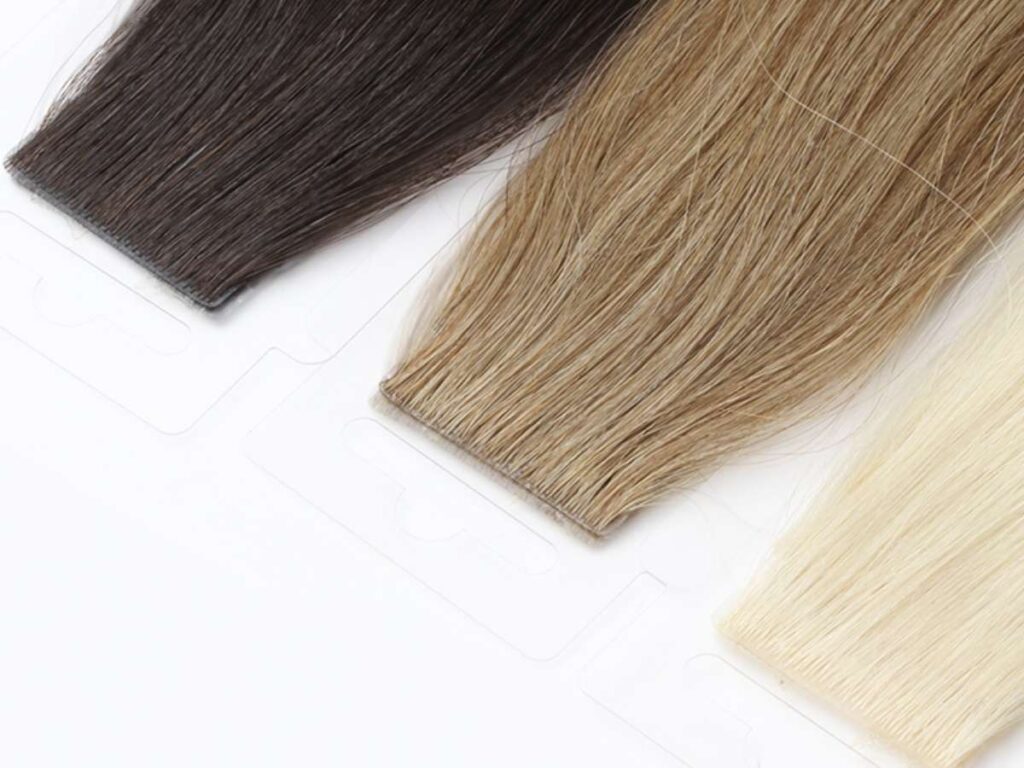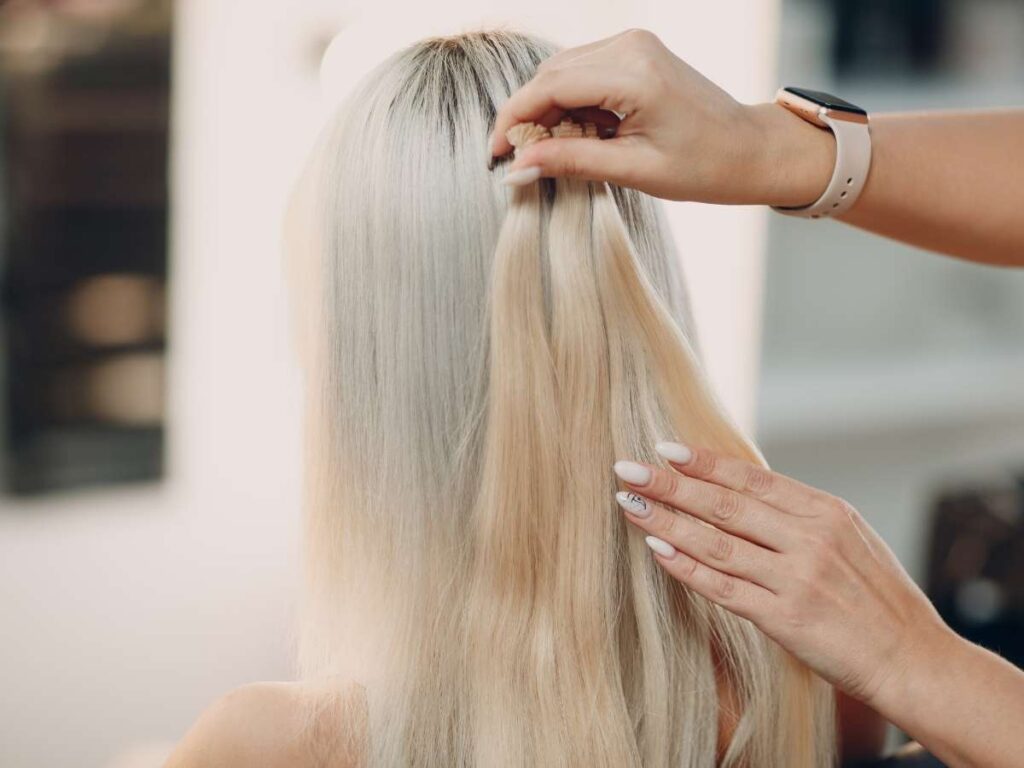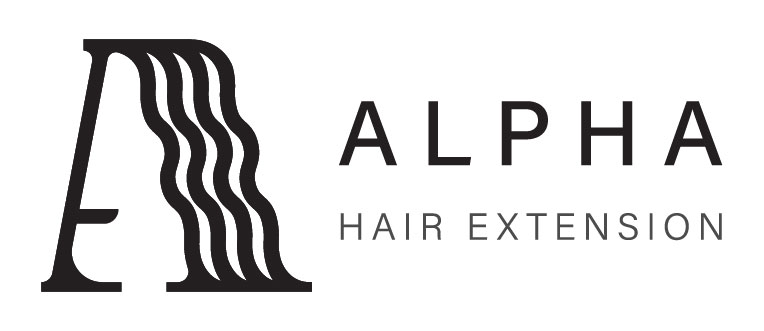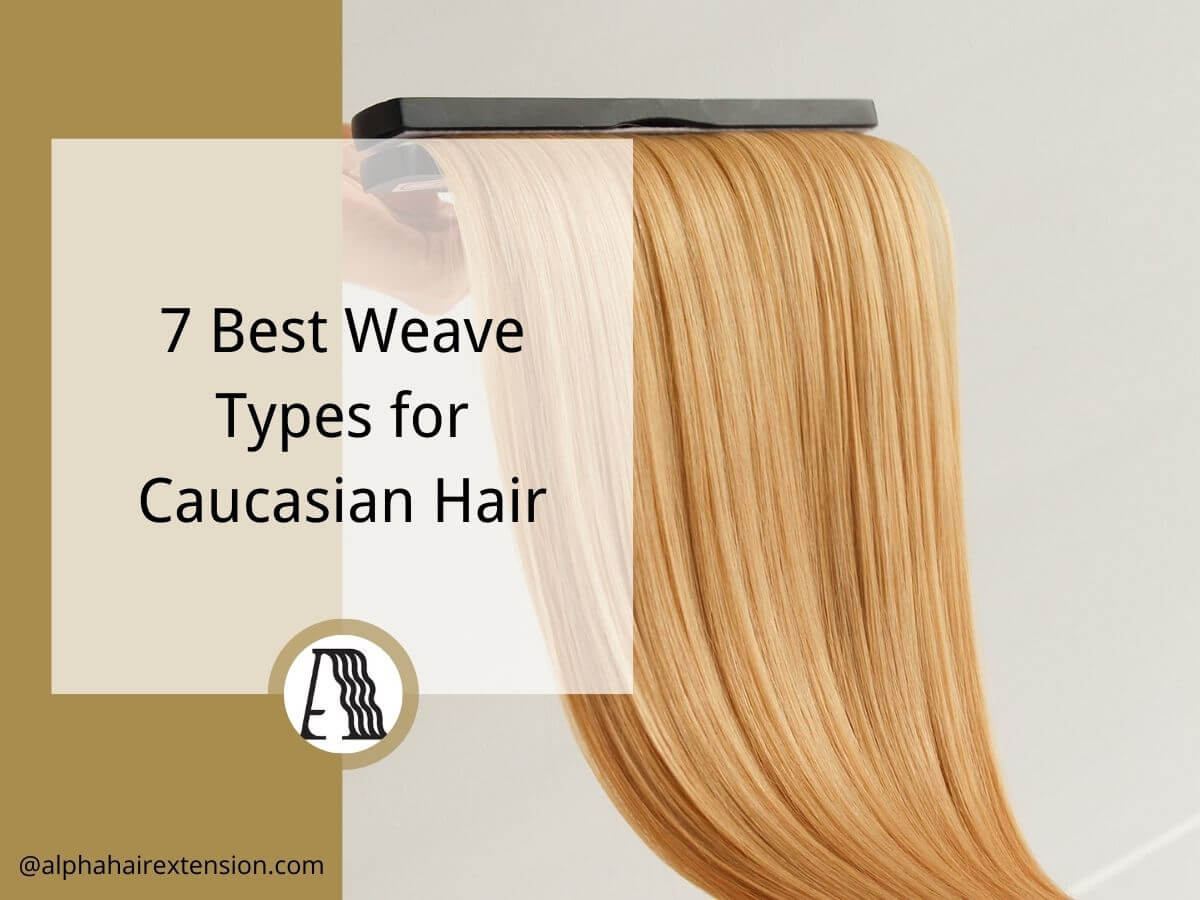I used to think estimating tape-in extensions was easy—until I ended up with a half-finished install. Not only did I have to reorder, but my client had to reschedule.
After that, I made sure to calculate everything down to the last tape. No more wasted time or product.
This guide is built on experience, with input from salon owners, hairstylists, and distributors. Here’s what you will learn:
- How many tape-in extensions are actually needed based on hair type.
- What factors affect quantity.
- Pro tips for getting a natural, seamless look.
By the end of this article, you’ll know exactly how many packs to buy based on hair length, density, and client preferences. No more second-guessing.
So let’s start!
1. What is Tape-In Hair Extension?
Tape-in hair extensions are a semi-permanent method that provides clients with added length and volume without the damage of traditional bonding techniques. Personally, I love it because they are lightweight, reusable, and designed for a natural blend with real hair.
The Purpose of Tape-In Hair Extensions in the Beauty Industry
Tape-in extensions fill the gap between temporary and permanent hair solutions. They offer the convenience of clip-ins with the longevity of bonded extensions— without damage. That’s why so many business owners stock them as a staple service.
Clients love them because:
- They add instant length and volume.
- They’re lightweight and comfortable to wear.
- They don’t require heat or glue, reducing hair damage.
As a business owner, you benefit too. Tape-ins are reusable, meaning clients come back for maintenance rather than a full replacement. That’s repeat business without constantly upselling new products.
Key Features of Tape-In Hair Extensions
So, why are tape-in extensions one of the most popular choices in salons?
- Thin, Flexible Tape Wefts – The adhesive wefts lie flat against the scalp, creating a natural, undetectable look.
- Quick Application – A full head install takes 30-60 minutes, saving you time and allowing you to book more clients.
- Reusable for Multiple Installs – With proper care, they last 6-8 weeks per install and can be retaped and reapplied.
- Versatile Styling – Clients can curl, straighten, and style their hair just like they would with their natural hair.
- Gentle on Natural Hair – Unlike keratin bonds or sew-ins, tape-ins don’t require excessive tension or heat.

2. How Tape-In Hair Extensions Work?
Have you ever had a client worried about extensions damaging their natural hair? I’ve had plenty of clients ask the same thing. When I first started using tape-ins, I was amazed at how lightweight and gentle they were compared to other methods. Now, I understand the process, it became my go-to extension service.
The Tape-In Application Process
Applying tape-in extensions is fast, efficient, and non-damaging when done correctly. Here’s how the process works in a salon setting:
- Hair Preparation – The client’s hair must be clean and free of any product buildup for the tape to stick properly. A clarifying shampoo works best.
- Sectioning the Hair – The hair is divided into small, even sections for precise placement.
- Placing the Extensions – A thin section of natural hair is paired between two tape-in wefts. The adhesive bonds securely without heat or glue.
- Pressing and Securing – Light pressure is applied to ensure the tapes hold firmly.
- Blending and Styling – Once all extensions are in place, the hair is trimmed and styled for a seamless finish.
3. How to Calculate the Number of Extensions Needed
Underestimating the number of extensions needed can lead to frustrating reschedules and delays. To prevent this, professionals should have a reliable system in place to calculate the correct quantity for every client.
Here are the steps involved:
Step 1: Determine Hair Type and Density
The first step is assessing your client’s natural hair thickness. This determines how many extension pairs are needed.
- Fine Hair → 10-15 pairs (20-30 tapes)
- Medium Hair → 20-25 pairs (40-50 tapes)
- Thick Hair → 30-40 pairs (60-80 tapes)
Quick Check: Hold a small section of hair. If you can easily see through it, the hair is fine. If it feels dense and full, it’s thick.
Step 2: Consider Hair Length
Shorter hair requires more extensions to blend properly. Use this guideline for a seamless install:
- Chin-Length or Shorter → Add 5-10 extra pairs.
- Shoulder-Length or Longer → Standard number of pairs applies.
- Extra Long Hair (Below Mid-Back) → Consider increasing by 5 pairs for balance.
Step 3: Define the Client’s Volume Goal
Not every client wants maximum fullness. Some just need a little boost. Here’s how volume affects tape-in quantity:
- Light Volume (Natural Look) → 10-15 pairs.
- Medium Volume (Everyday Fullness) → 20-25 pairs.
- Maximum Volume (Thick, Glamorous Look) → 30-40 pairs.
Tip: Always ask clients for photo examples of their desired look. Their definition of “full volume” may be different from yours.
Step 4: Convert to Pack Quantity
Most brands sell tape-ins in packs containing 10-12 pairs per pack. Use this guide for ordering:
| Hair Type | Pairs Needed | Number of Packs |
| Fine Hair | 10 to 15 | 2 to 3 |
| Medium Hair | 20 to 25 | 3 to 4 |
| Thick Hair | 30 to 40 | 4 to 5 |
Tip: Always round up if unsure. It’s better to have extra than to run out mid-install.
Step 5: Adjust for Special Cases
Certain clients may need adjustments based on:
- Layered Haircuts – More tapes are needed to fill in shorter layers.
- Blending Needs – Short, blunt cuts require extra extensions for a smooth transition.
- Head Size – Larger heads may require additional pairs for full coverage.
4. Key Factors Influencing Extension Quantity
Determining the correct number of tape-in extensions is essential for achieving consistent, high-quality results. Selecting the right quantity ensures proper blending, avoids excess bulk, and maintains cost efficiency. The following factors influence how many extensions are needed for each client:
Hair Thickness
Hair thickness is the biggest factor in determining how many extensions needed. If hair is thin or fine, 20-40 pieces (1-2 packs) are enough to add volume. Those with medium hair usually need 40-60 pieces (2-3 packs) for balanced coverage. For thicker hair, at least 60-80 pieces (3-4 packs) are required to blend properly.
Hair Length
The length of natural hair also affects how many tape-ins you’ll need. Short hair often requires more extensions to create a smooth and even look. Since shorter hair has blunt ends, additional wefts help blend the transition. Medium to long hair generally needs fewer pieces since the extensions mix more naturally.
Desired Look
The desired outcome plays a crucial role in determining the number of extensions needed. For a subtle, natural enhancement, 20-40 pieces are typically sufficient. However, for a dramatic transformation with significant volume, 60-80 pieces may be required to achieve a full, glamorous look.
Head Size
Larger head circumferences require additional extensions for full scalp coverage and even weight distribution. A smaller head size may need fewer pieces to maintain a balanced, natural look. During consultation, measuring head dimensions can prevent under- or over-ordering.
Natural Hair Density
Clients with thicker natural hair need additional extensions to ensure even volume distribution. Insufficient wefts can create an imbalance where the lower portion appears significantly fuller than the top. Using the appropriate number of extensions prevents bulkiness at the ends while maintaining a seamless finish.

5. General Estimation for Different Hair Types
The number of tape-in extensions needed depends on hair type, thickness, and length. The table below provides a general estimate for achieving a natural, balanced look:
| Hair Type | Recommended Pieces | Packs Needed | Best For |
| Very Fine or Thinning Hair | 10-20 pieces | 1 pack | Minimal volume boost, filling in sparse areas |
| Thin or Fine Hair | 20-40 pieces | 1-2 packs | Light volume, subtle length increase |
| Medium Hair | 40-60 pieces | 2-3 packs | Balanced fullness, added length |
| Thick Hair | 60-80 pieces | 3-4 packs | Seamless blending, natural-looking thickness |
| Very Thick or Short Hair | 80-100+ pieces | 4+ packs | Heavy blending, full transformation |
| Curly or Textured Hair | 60-100+ pieces | 3-5 packs | Even volume distribution, blending with natural curls |
6. Mistakes to Avoid when Choosing The Extension Quantity
Ordering the wrong number of tape-in extensions can lead to wasted inventory, unhappy clients, and lost time. Here are the most common mistakes salon owners and stylists make when estimating extension quantity—and how to avoid them.
Underestimating the Number of Pairs Needed
One of the biggest mistakes is ordering too few extensions and running out mid-install. This forces you to either:
- Stop the service and reschedule (frustrating for you and the client).
- Rush to order more, delaying the process.
- Try to “stretch” the extensions, leading to a thin, unnatural result.
How to Avoid It:
- Always assess the client’s hair density and volume goals before ordering.
- Use a standard calculation guide based on hair type (fine, medium, or thick).
- Keep one extra pack on hand for emergencies.
Ignoring Hair Length and Blending Needs
Not all hair lengths require the same number of extensions. Short, blunt cuts need more pairs to create a smooth transition, while layered cuts require fewer.
How to Avoid It:
- If the client has short hair (above shoulders), add 5-10 extra pairs.
- If working with long hair, focus on strategic placement rather than excessive volume.
Not Considering Head Size and Scalp Coverage
Every client’s head size varies. A smaller head may need fewer extensions, while a larger one requires more pairs for full coverage.
How to Avoid It:
- Adjust extension quantity based on scalp coverage needs.
- Don’t assume the same number works for every client.
Not Having a Backup Plan
Even with careful planning, things don’t always go as expected. A client might decide they want more volume mid-install, or you could encounter a miscalculation.
How to Avoid It:
- Keep an extra pack in stock for last-minute adjustments.
- Have a reliable supplier who can provide quick restocks when needed.
7. Tips on How To Choose The Right Quantity for Your Hair Goals
Choosing the right number of tape-in extensions is essential for achieving a natural look of your customer. The right amount prevents the hair from looking too thin or overly bulky.
Here’s how to get the quantity right every time:
Tip #1: Define the Client’s Volume Goal
Every client has a different idea of what “full” means, so it’s important to set clear expectations before ordering extensions. Some want subtle enhancement, while others want a dramatic transformation. Ask clients for photo examples to match their vision with the correct extension quantity.
Tip #2: Consider Hair Density and Length
Hair thickness and length impact how many extensions are needed for a seamless blend. Fine hair needs fewer pairs, while thick hair requires more even coverage. Short hair, especially blunt cuts, often requires 5-10 extra pairs to blend naturally into extensions.
Tip #3: Match Extension Texture to Natural Hair
Extensions should blend effortlessly with the client’s natural hair. Using straight extensions on wavy or curly hair can create a mismatched appearance, leading to extra tapes being used unnecessarily. Choose the correct texture from the start to avoid needing more pairs than necessary.
Tip #4: Adjust for Head Size and Scalp Coverage
Head size varies from client to client, affecting the number of extensions needed. A smaller head requires fewer pairs, while a larger head needs more to ensure full coverage. Take scalp measurements during consultations to avoid ordering too many or too few.
Conclusion
Ordering the right number of tape-in extensions isn’t just about saving money—it’s about seamless installs, happy clients, and smooth operations. That’s why knowing the right amount of tape-in extension matters.
I used to struggle with miscalculations, but now I have a simple process. You can too. No more mid-install surprises or overstocked inventory.
So, what’s stopping you from making better extension orders?
Contact with us today and let’s find the right tape-ins for your business needs!
Explore Related Resources
Want to see more products? We’ve got plenty of options that might just be the perfect fit for you:
Still haven’t found what you’re looking for? Don’t hesitate to contact us. We’re available around the clock to assist you.







